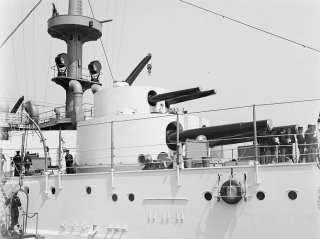Why No One Remembers America's Two Kearsarge-Class Battleships
Poorly-made and easy to sink.
Key Point: These new ships were supposed to be a big improvement. They weren't good, but the Navy did learn a number of vital lessons from them.
The U.S. Navy’s Kearsarge-class was a small class, with just two hulls were completed. Despite the low number, the class was intended for greatness, but had some pretty serious design flaws.
Good Intentions
The Kearsarge-class had some improvements compared to the battleships that preceded it—they were better armored, were faster, and had larger, faster-firing guns arranged in a novel double-deck turret arrangement—but there were some serious design flaws that doomed the class.
Flawed Design
Because the gun turrets had vertical rather slanted walls, the 13-inch gun ports had to be particularly large to give the guns the necessary elevation for distance shots. While the large ports did give the guns the needed maneuverability, they left the turrets dangerously exposed.
From the deck, the turret floors could be seen. A well-placed shot that managed to pass through the turret port would explode inside the turret, likely disabling the gun, and could even cause the magazine to explode, seriously compromising the ship’s safety. Additionally, the 13-inch guns had to be returned to a slight 2 degrees of elevation in order to be reloaded, hampering their reload time.
The 8-inch guns above the 13-inch guns also suffered from design issues. Along with the 13-inch main guns, they had been designed prior to smokeless powder and were intended to use brown powder propellant. With the introduction of smokeless powder, the volume of needed propellant per shot decreased, and the rate of fire correspondingly increased. Although an increase in fire would normally be positive, in actuality this meant that the 13 and 8-inch guns ran the danger of interfering with each other’s shots.
Supporting the turreted main guns were fourteen 5-inch guns, seven to each side of the ship. During sea trials, the Navy realized that the center gun on both sides of the ship had been designed too close to the waterline—too close to the water. When seas were anything but calm, seawater washed over the gun, making it very ineffective.
Though the Kearsarge-class was well protected using the latest Harvey armor, the protection between guns was poor. Specifically, the 5-inch guns had no protection from each other—there were no screens between guns, so a direct hit on one gun had the potential to take out the adjacent guns as well.
Great White Fleet
A brainchild of Theodore Roosevelt, the Great White Fleet was named after a group of United States Navy ships that toured the world in 1907 as a demonstration of the United States’ naval might. Both the USS Kentucky and the USS Kearsarge participated in the journey, which lasted two years, despite their shortcomings as battleships.
In 1920, the Kearsarge was stripped of armor, guns, and superstructure and turned into a crane ship, and lifted supplies and components for other ships until 1948.
The Kentucky had a slightly more illustrious career. In 1906, the Kentucky was used in the 1906-09 American occupation of Cuba. 1915-16, she patrolled near Veracruz in the Gulf of Mexico during the American occupation and was later worked up as a training ship once the United States entered World War I. She was scrapped in 1923.
Despite some modern features, the ships were immature in design and had serious flaws—some of which were detrimentally carried over to the battleships that followed the Kearsarge-class.
Caleb Larson holds a Master of Public Policy degree from the Willy Brandt School of Public Policy. He lives in Berlin and writes on U.S. and Russian foreign and defense policy, German politics, and culture.
This first appeared in 2020 and is being reposted due to reader interest.
Image: Wikimedia

